Bryan L. Programmable controllers. Theory and implementation
Подождите немного. Документ загружается.

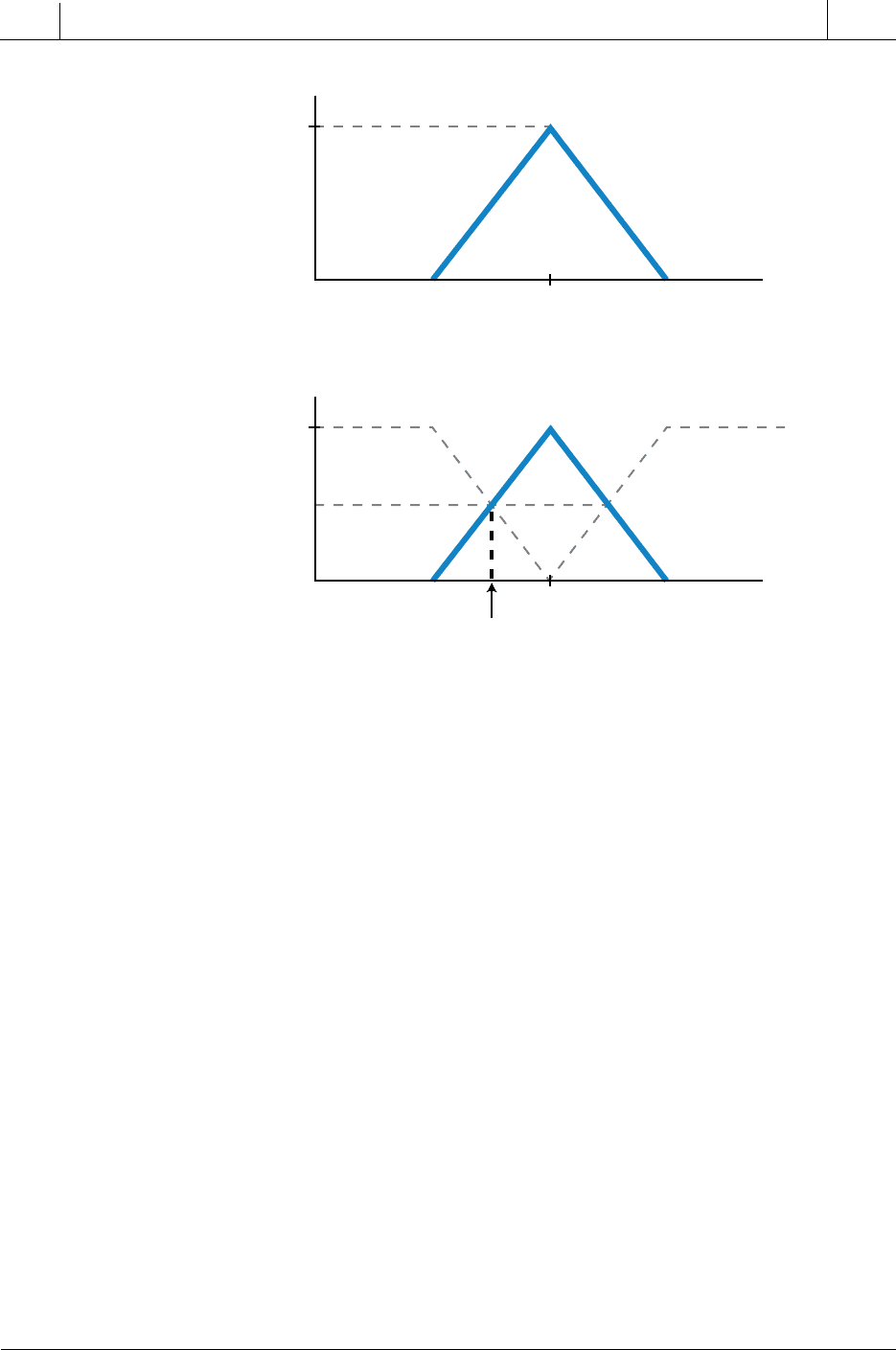
799
CHAPTER
17
Fuzzy
Logic
SECTION
5
Advanced PLC
Topics and Networks
Industrial Text & Video Company 1-800-752-8398
www.industrialtext.com
In real life, this fuzzy logic temperature algorithm can be associated with
the decision you make about the type of clothing you wear at different times
of the year. The type of clothing is based on the temperature (input) and its
grade representation. As shown in Figure 17-3, at 70°F, you may only
need a short-sleeved shirt and pants. However, as the temperature drops to
65°F, you may decide to wear a long-sleeved shirt instead of a short-sleeved
one. Moreover, if the input is 25% cool and 75% cold (62.5°F), then you
may decide to add another layer, a jacket, based on the temperature and its
value of coolness. As we will explain later, a fuzzy system’s output may be
based on several inputs, not just one, like temperature. In this situation, the
output decision is made using the knowledge base represented in the fuzzy
logic graph.
Fuzzy logic requires knowledge in order to reason. This knowledge, which is
provided by a person who knows the process or machine (the expert), is stored
in the fuzzy system. For example, if the temperature rises in a temperature-
regulated batch system, the expert may say that the steam valve needs to be
turned clockwise a “little bit.” A fuzzy system may interpret this expression
as a 10-degree clockwise rotation that closes the current valve opening by 5%.
As the name implies, a description such as a “little bit” is a fuzzy description,
meaning that it does not have a definite value.
Figure 17-2. (a) Cool air temperature range with (b) dotted lines showing not cool range.
Grade
1
0
60°F70°F80°F
Temperature
Cold HotCool
Grade
1
0
0.5
60°F70°F80°F
Temperature
Not Cool Not Cool
Cold Hot
Cool
(a)
(b)
65°F means 50% cool
50% cold
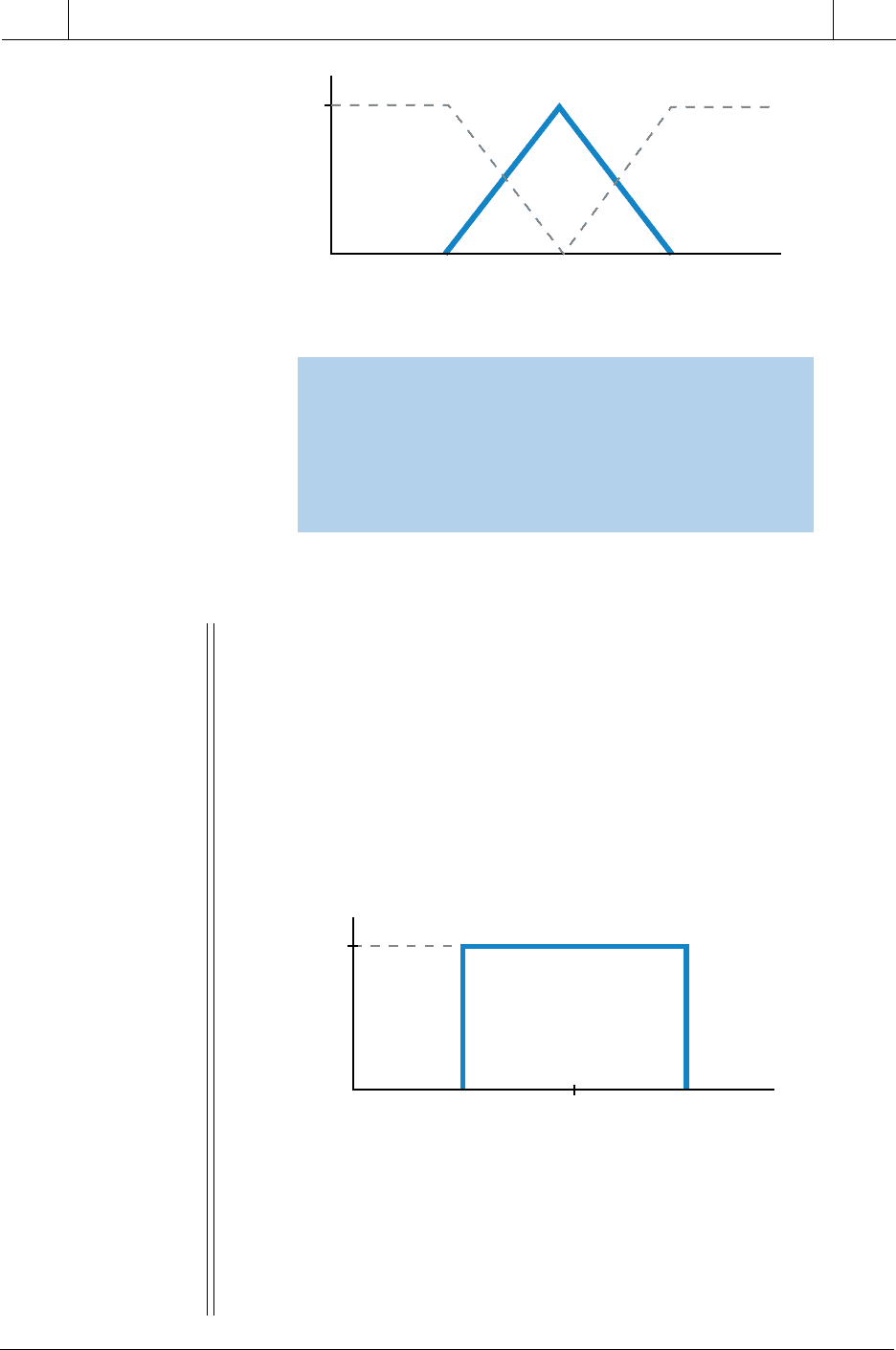
800
SECTION
5
Advanced PLC
Topics and Networks
Industrial Text & Video Company 1-800-752-8398
www.industrialtext.com
CHAPTER
17
Fuzzy
Logic
EXAMPLE 17-1
Figure 17-4 illustrates one representation of age (i.e., young, middle
age, and old) based on the number of years a person has been alive.
In this representation, the exact moment that someone passes the age
of 35, he or she is considered middle-aged. Illustrate (a) a fuzzy logic
representation of this same set of ages, and (b) how the representation
would change if the age was divided into four ranges: young (up to 35
years), middle age (35–55 years), mature (45–65 years), and old
(more than 65 years).
Figure 17-3. Fuzzy logic graph illustrating clothing choices based on temperature.
Grade
1
0
35 45 55
Age
Young OldMiddle Age
Figure 17-4. Age representation graph.
SOLUTION
(a) Figure 17-5 shows a triangular fuzzy representation that
describes the age ranges. In this graph, a person who is 45 years old
is perfectly middle-aged, while a person who is 50 years old is 50%
middle-aged and 50% old.
1
0
Long-sleeved
shirt with
sweater
Short-sleeved shirt
and pants
T-shirt and
shorts
Cold Cool Hot
60°F70°F80°F
IF temperature is 70°F (grade 1–100% cool),
THEN wear short-sleeved shirt and long pants
IF temperature is 65°F (0.5 cold, 0.5 cool),
THEN wear long-sleeved shirt and long pants
IF temperature is 62.5°F (0.25 cool, 0.75 cold),
THEN wear long-sleeved shirt with a sweater and long pants
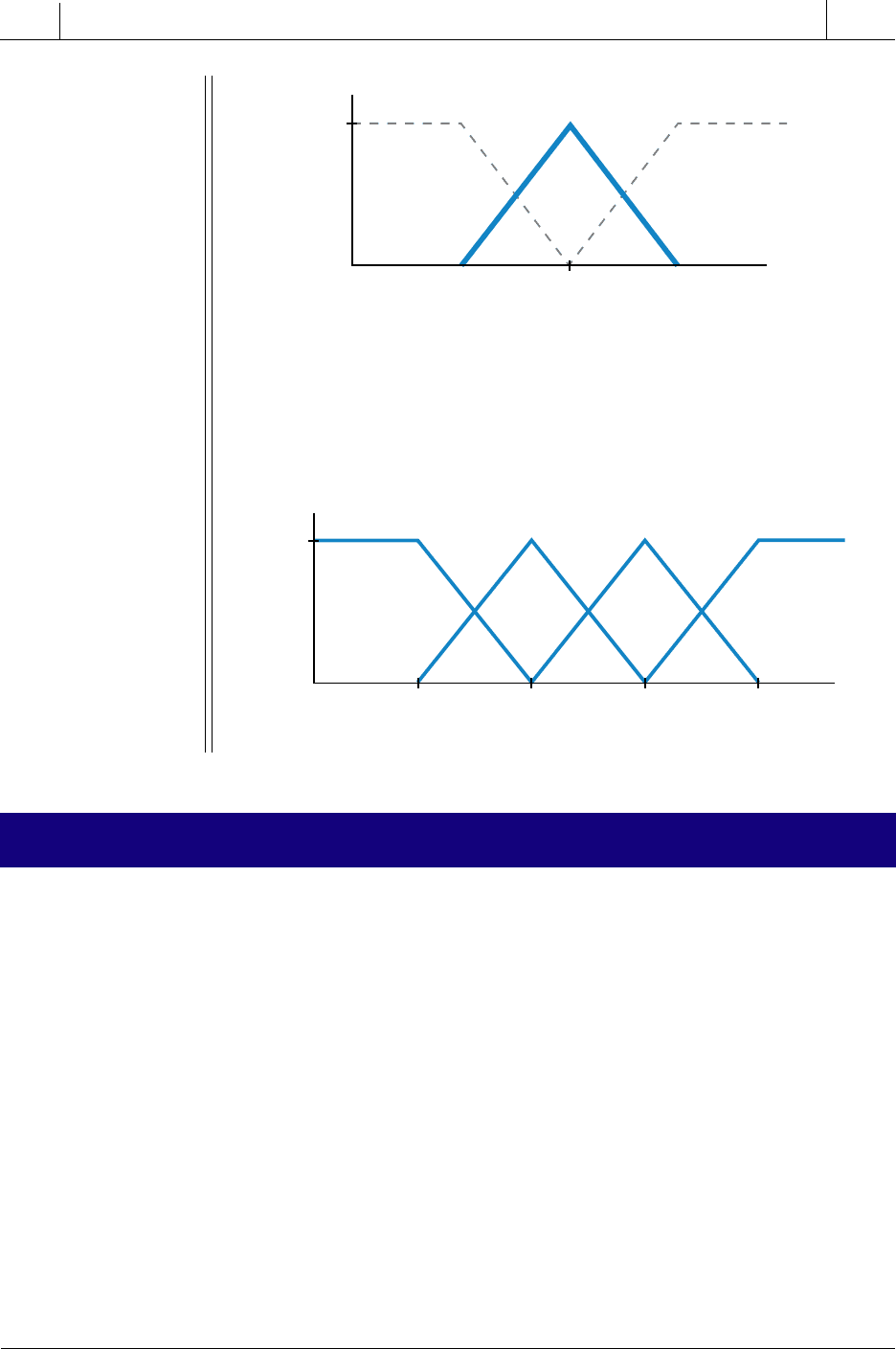
801
CHAPTER
17
Fuzzy
Logic
SECTION
5
Advanced PLC
Topics and Networks
Industrial Text & Video Company 1-800-752-8398
www.industrialtext.com
Grade
1
0
35 45 55
Age
Young OldMiddle
Age
Figure 17-5. Fuzzy logic age ranges.
(b) Figure 17-6 illustrates the fuzzy logic representation for the four
age groups: young, middle age, mature, and old. In this chart, a
person who is 50 years old is 50% middle-aged and 50% mature.
Middle Age Mature OldYoung
Grade
1
0
35 6545 55
Age
Figure 17-6. Fuzzy logic graph using four age groups.
17-2 HISTORY OF FUZZY LOGIC
Fuzzy logic has existed since the ancient times, when Aristotle developed
the law of the excluded middle. In this law, Aristotle pointed out that the
middle ground is lost in the art of logical reasoning—statements are either
true or false, never in-between. When PLCs were developed, their discrete
logic was based on the ancient reasoning techniques. Thus, inputs and outputs
could belong to only one set (i.e., ON or OFF); all other values were excluded.
Fuzzy logic breaks the law of the excluded middle in PLCs by allowing
elements to belong to more than just one set. In the cool air example, the 65°F
temperature input belonged to two sets, the cool set and the cold set, with
grade levels indicating how well it fit into each set.
The origins of fuzzy logic date back to the early part of the twentieth century
when Bertrand Russell discovered an ancient Greek paradox that states:
A Cretan asserts that all Cretans lie. So, is he lying? If he lies, then
he is telling the truth and does not lie. If he does not lie, then he tells
the truth and, therefore, he lies.
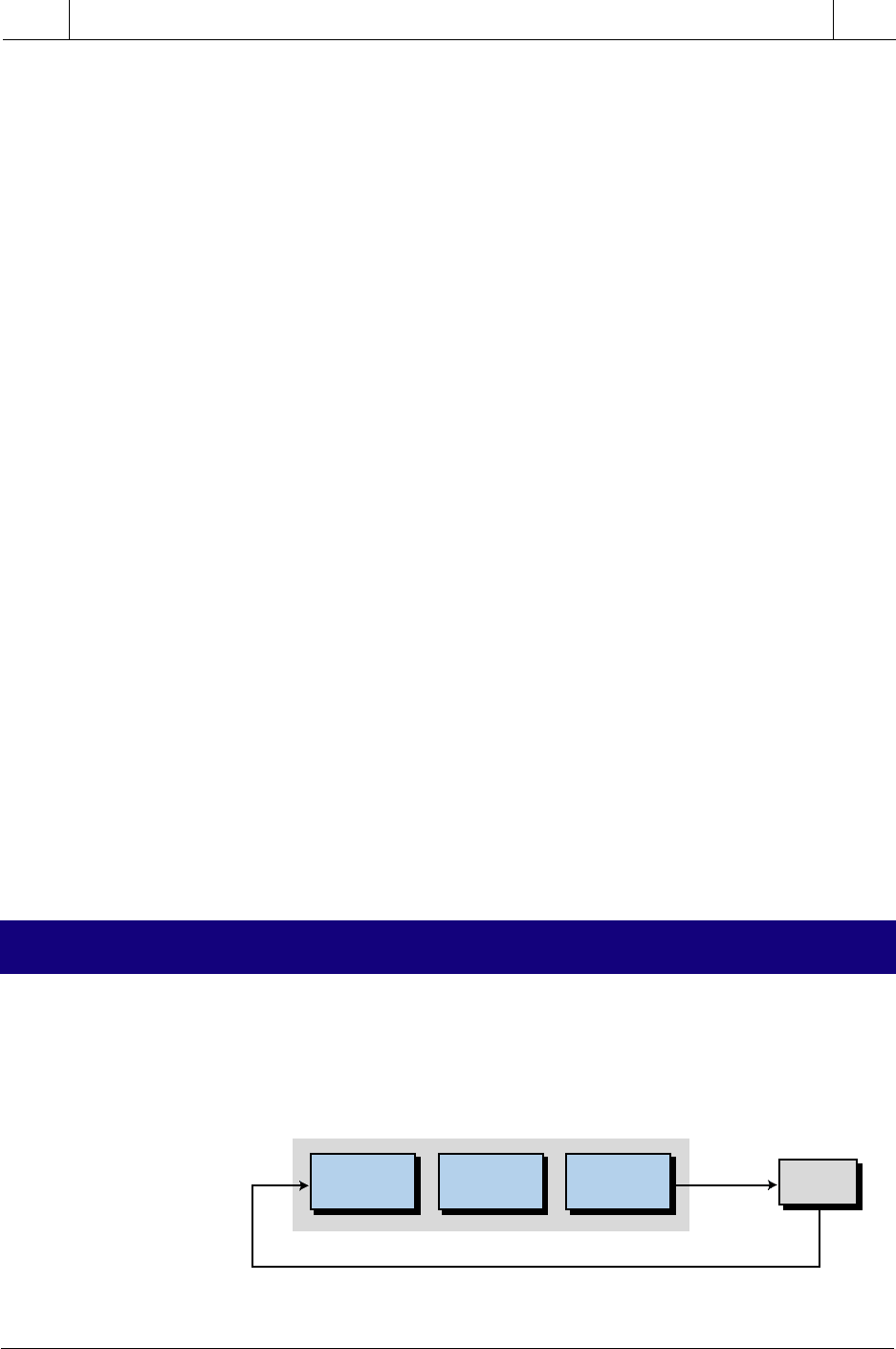
802
SECTION
5
Advanced PLC
Topics and Networks
Industrial Text & Video Company 1-800-752-8398
www.industrialtext.com
CHAPTER
17
Fuzzy
Logic
In either case—that all Cretans lie or that all Cretans do not lie—a contradic-
tion exists, because both statements are true and false. Russell found that
this same paradox applied to the set theory used in discrete logic. Statements
must either be totally true or totally false, leading to areas of contradiction.
Fuzzy logic surmounted this problem in classical logic by allowing state-
ments to be interpreted as both true and false. Therefore, applying fuzzy logic
to the Greek paradox yields a statement that is both true and false: Cretans
tell the truth 50% of the time and lie 50% of the time. This interpretation is
very similar to the idea of a glass of water being half empty or half full. In
fuzzy logic the glass is both—50% full and 50% empty. Even as the amount
of water decreases, the glass still retains percentages of both conditions.
Around the 1920s, independent of Bertrand Russell, a Polish logician named
Jan Lukasiewicz started working on multivalued logic, which created frac-
tional binary values between logic 1 and logic 0. In a 1937 article in
Philosophy of Science, Max Black, a quantum philosopher, applied this
multivalued logic to lists (or sets) and drew the first set of fuzzy curves,
calling them vague sets. Twenty-eight years later, Dr. Lofti Zadeh, the
Electrical Engineering Department Chair at the University of California at
Berkeley, published a landmark paper entitled “Fuzzy Sets,” which gave the
name to the field of fuzzy logic. In this paper, Dr. Zadeh applied
Lukasiewicz’s logic to all objects in a set and worked out a complete algebra
for fuzzy sets. Due to this groundbreaking work, Dr. Zadeh is considered to
be the father of modern fuzzy logic.
Around 1975, Ebrahim Mamdani and S. Assilian of the Queen Mary College
of the University of London (England) published a paper entitled “An
Experiment in Linguistic Synthesis with a Fuzzy Logic Controller,” where
the feasibility of fuzzy logic control was proven by applying fuzzy control to
a steam engine. Since then, the term fuzzy logic has come to mean
mathematical or computational reasoning that utilizes fuzzy sets.
yg y
Fuzzy Logic
Processing
Fuzzy
Output
Fuzzy
Input
Process
Input
Data
Output
Data
Figure 17-7. Fuzzy logic control system.
Figure 17-7 illustrates a fuzzy logic control system. The input to the fuzzy
system is the output of the process, which is entered into the system via input
interfaces. For example, in a temperature control application, the input data
would be entered using an analog input module. This input information would
17-3 FUZZY LOGIC OPERATION
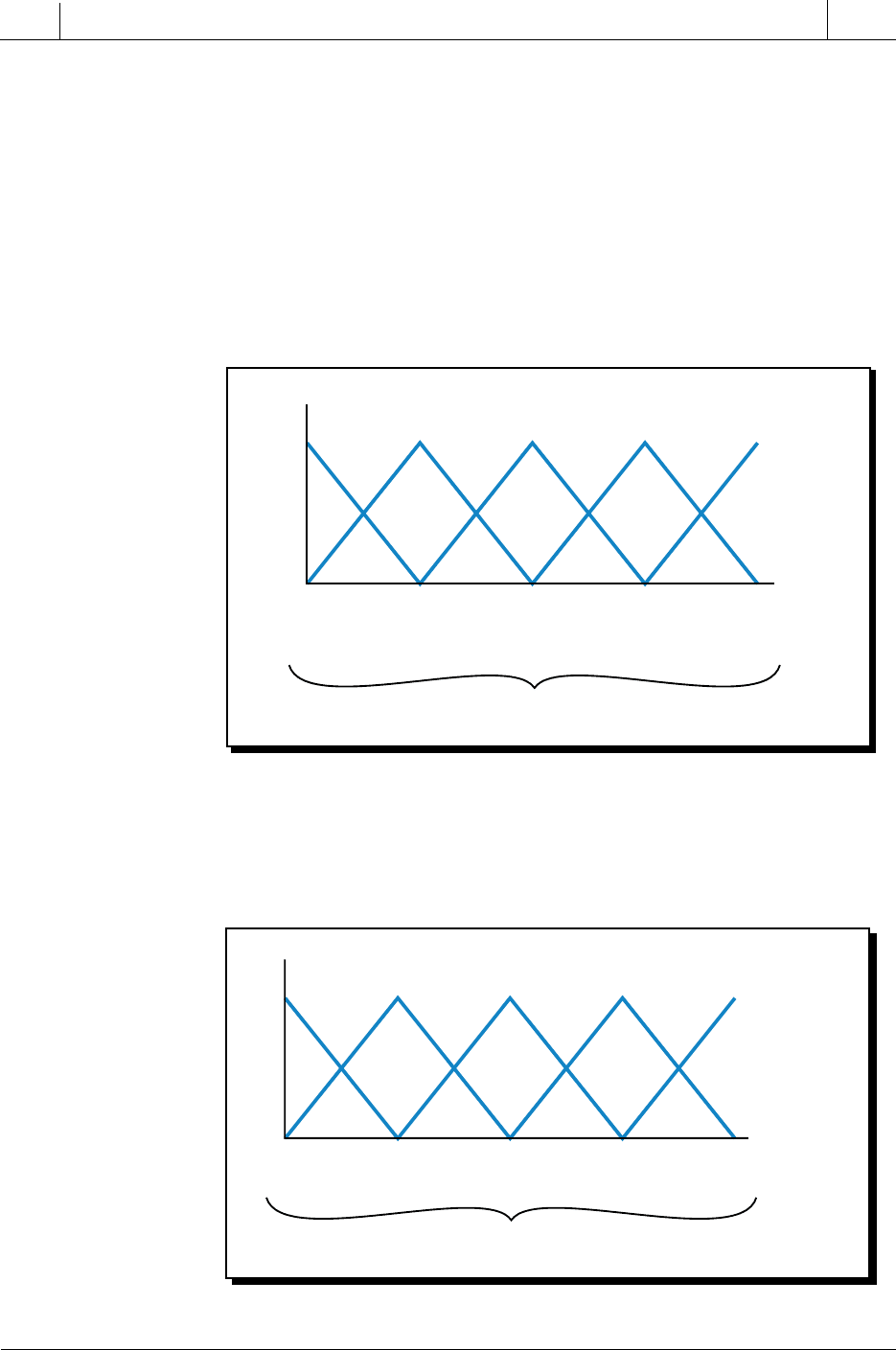
803
CHAPTER
17
Fuzzy
Logic
SECTION
5
Advanced PLC
Topics and Networks
Industrial Text & Video Company 1-800-752-8398
www.industrialtext.com
then go through the fuzzy logic process, where the processor would analyze
a database to obtain an output. Fuzzy processing involves the execution of
IF...THEN rules, which are based on the input conditions. An input’s grade
specifies how well it fits into a particular graphic set (e.g., too little, normal,
too much). Note that input data, as shown in Figure 17-8, may also be
represented as a count value ranging from 0 to 4095 or as a percentage of
error deviation. If the fuzzy logic system utilizes an analog input that has a
count range from 0 to 4095, the graphs representing the input will cover the
span from 0 to 4095 counts. Furthermore, the analog input information (0–
4095 counts) may represent an error range, from –50% to +50%, of a process.
Figure 17-8. Input data to a fuzzy logic system represented as counts and percentages.
The output of a fuzzy controller is also defined by grades, with the grade
determining the appropriate output value for the control element. The output
of the fuzzy logic system in Figure 17-9, for example, controls a steam valve,
Figure 17-9. Output data from a fuzzy logic system represented as counts and percentages.
0 counts 4095 counts
0% open
2048 counts
50% open 100% open
Output data
from fuzzy logic system
1
0
Grade
Less Open Normal Open More Open
Steam Valve
100°F 200°F
125°F 150°F 175°F
1
0
Grade
Too Little Normal Too Much
Temp
0 counts 4095 counts
2048 counts
–50% 50%
0% error
Input data
to fuzzy lo
g
ic system
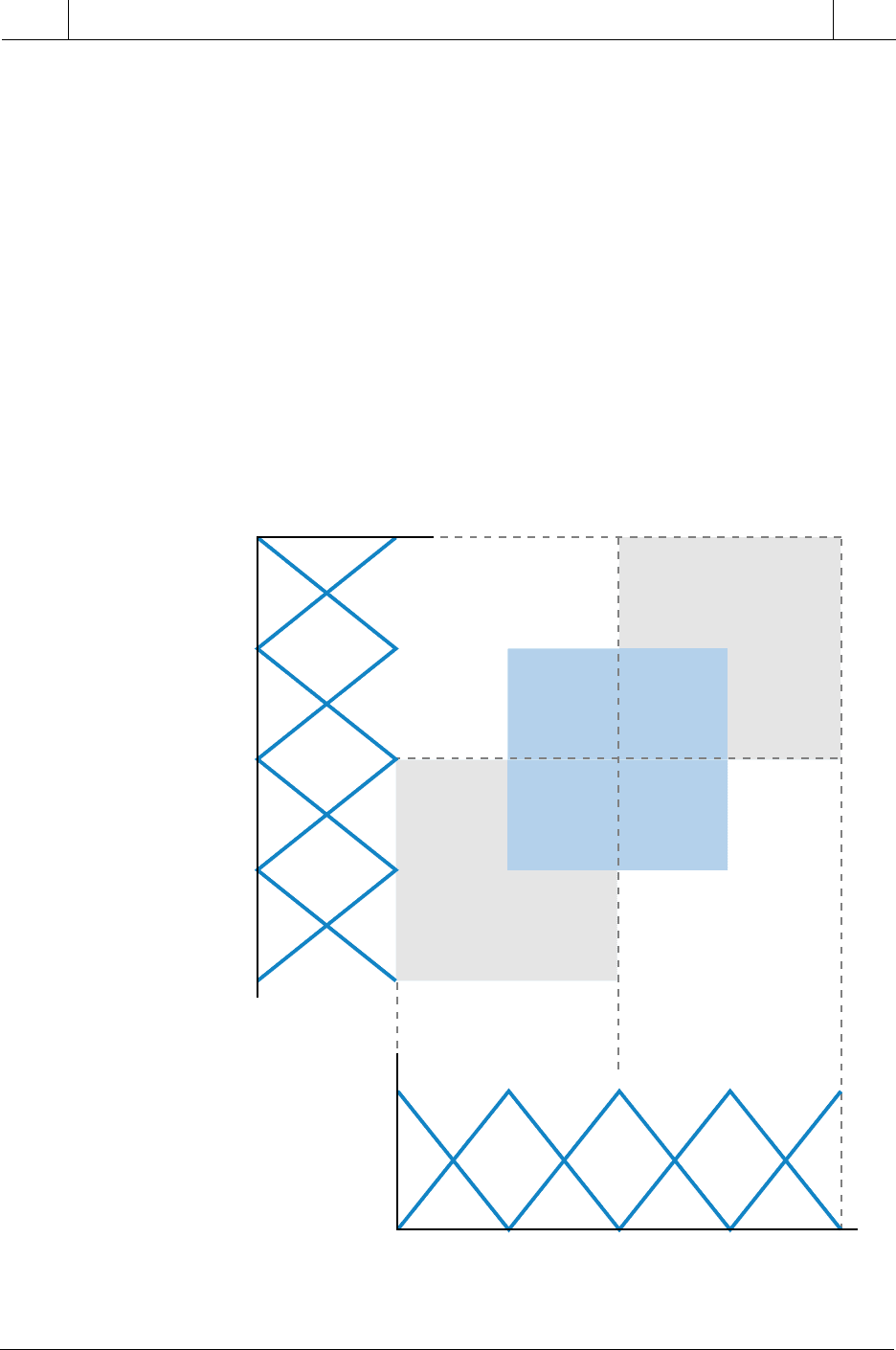
804
SECTION
5
Advanced PLC
Topics and Networks
Industrial Text & Video Company 1-800-752-8398
www.industrialtext.com
CHAPTER
17
Fuzzy
Logic
which opens or closes according to its grade on the output chart. Figure 17-
10 illustrates a fuzzy logic cooling system chart with both input and output
grades, where the horizontal axis is the input condition (temperature) and the
vertical axis is the output (air-conditioner motor speed). In this chart, a single
input can trigger more than one output condition. For example, if the input
temperature is 137.5°F, then the temperature is part of two input curves—it
is 50% too cool and 50% normal. Consequently, the input will trigger two
outputs—the too cool input condition will trigger a less speed output, while
the normal input will trigger a normal speed output condition. Since the fuzzy
logic controller can have only one output, it completes a process called
defuzzification (explained later) to determine the actual final output value.
The implementation and operation of a fuzzy logic control system is similar
to the implementation of PID control using intelligent interfaces, where the
module reads the input, processes the information, and provides an output.
Figure 17-10. Fuzzy logic system chart showing both input and output grades.
100°F 125°F 150°F 175°F 200°F
0 counts 4095 counts
1
0
Too Cool Normal Too Hot
4095 counts
100% 75% 50% 25% 0%
0 counts
1
0
More Speed Normal Speed Less Speed
IF too hot
THEN more speed
IF normal
THEN normal speed
IF too cool
THEN less speed
Temp
Motor
Speed
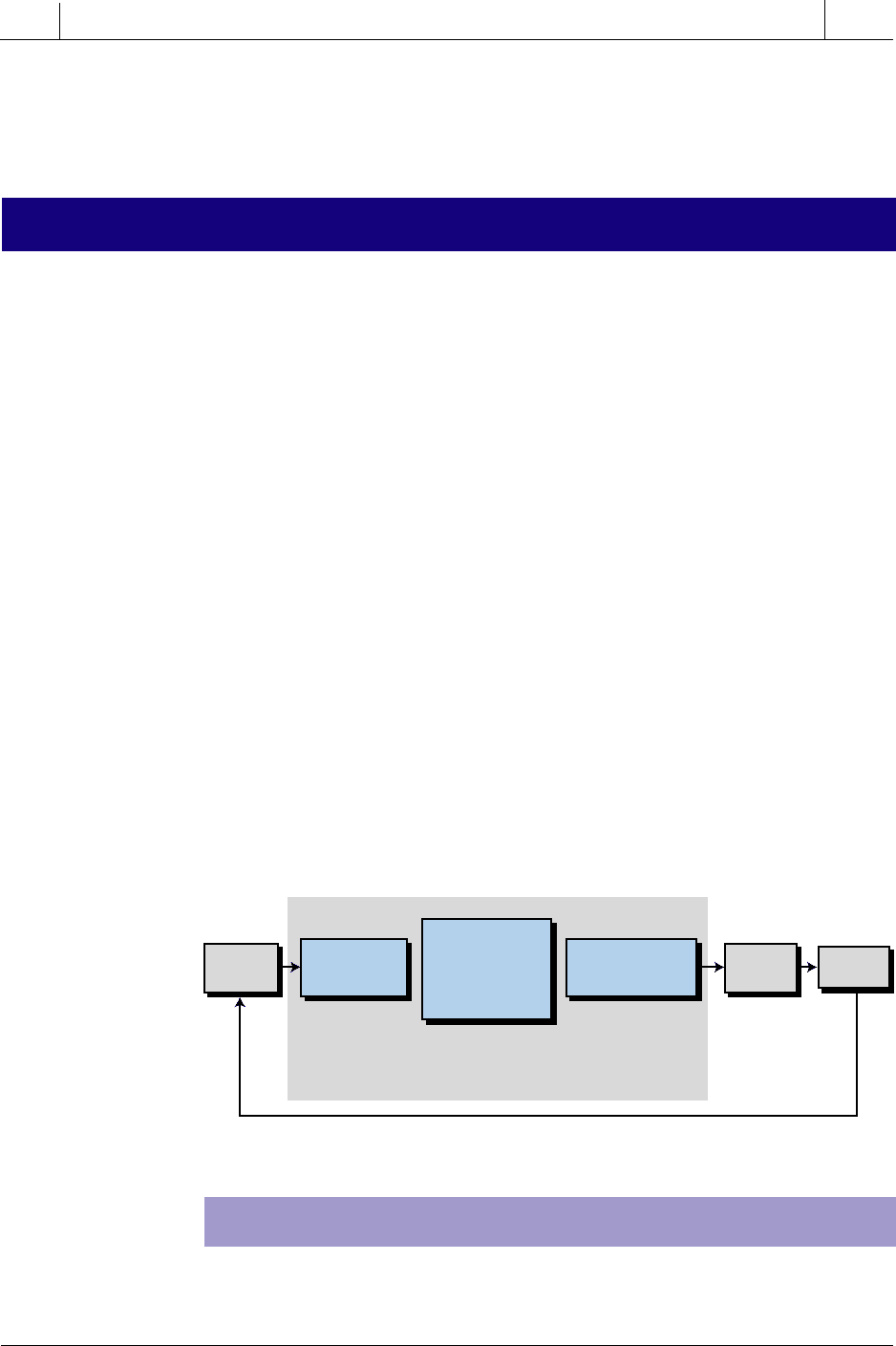
805
CHAPTER
17
Fuzzy
Logic
SECTION
5
Advanced PLC
Topics and Networks
Industrial Text & Video Company 1-800-752-8398
www.industrialtext.com
17-4 FUZZY LOGIC CONTROL COMPONENTS
Figure 17-11. Fuzzy logic controller operation.
In this section, we will explain the main components of a fuzzy logic
controller and also implement a simple fuzzy control program. The three
main actions performed by a fuzzy logic controller are:
• fuzzification
• fuzzy processing
• defuzzification
As shown in Figure 17-11, when the fuzzy controller receives the input data,
it translates it into a fuzzy form. This process is called fuzzification. The
controller then performs fuzzy processing, which involves the evaluation
of the input information according to IF…THEN rules created by the user
during the fuzzy control system’s programming and design stages. Once the
fuzzy controller finishes the rule-processing stage and arrives at an outcome
conclusion, it begins the defuzzification process. In this final step, the fuzzy
controller converts the output conclusions into “real” output data (e.g.,
analog counts) and sends this data to the process via an output module
interface. If the fuzzy logic controller is located in the PLC rack and does not
have a direct or built-in I/O interface with the process, then it will send the
defuzzification output to the PLC memory location that maps the process’s
output interface module.
However, fuzzy controllers are usually independent interfaces, which plug
into the PLC rack and use the PLC’s I/O system to communicate with the
process under fuzzy control. In Chapter 8, we discussed the operation and
interfacing of intelligent fuzzy logic modules.
FUZZIFICATION COMPONENTS
The fuzzification process is the interpretation of input data by the fuzzy
controller. Fuzzification consists of two main components:
Fuzzy Logic Controller
Input
Fuzzification
Fuzzy Rule
Processing and
Outcome/Output
Calculation
Output
Interface
Input
Interface
Process
Outcome/Output
Defuzzification
• Input Data
Association
• Rule Execution
• Output Deter-
mination
• Output Level
Computation
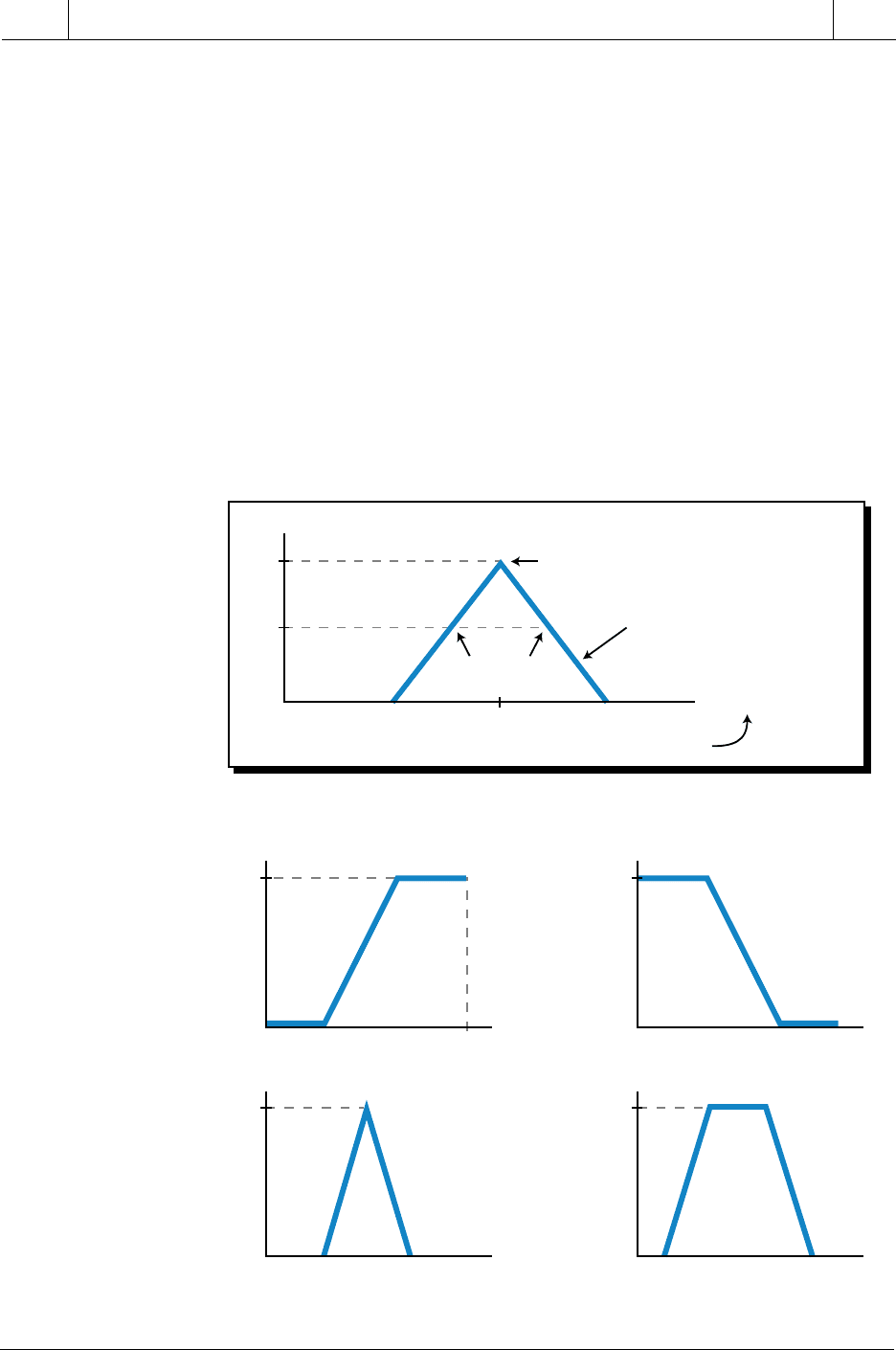
806
SECTION
5
Advanced PLC
Topics and Networks
Industrial Text & Video Company 1-800-752-8398
www.industrialtext.com
CHAPTER
17
Fuzzy
Logic
• membership functions
• labels
Membership Functions. During fuzzification, a fuzzy logic controller
receives input data, also known as the fuzzy variable, and analyzes it
according to user-defined charts called membership functions (see Figure
17-12). Membership functions group input data into sets, such as tempera-
tures that are too cold, motor speeds that are acceptable, etc. The controller
assigns the input data a grade from 0 to 1 based on how well it fits into
each membership function (e.g., 0.45 too cold, 0.7 acceptable speed).
Membership functions can have many shapes, depending on the data set, but
the most common are the S, Z, Λ, and Π shapes shown in Figure 17-13.
Note that these membership functions are made up of connecting line
segments defined by the lines’ end points. Each membership function can
have up to three line segments with a maximum of four end points. The grade
Figure 17-12. Membership function chart.
Figure 17-13. Membership function shapes: (a) S, (b) Z, (c)
Λ, and (d) Π.
Grade
1
0
0.5
Grade of 1.0
Grade of 0.5
60°F70°F80°F
Temperature Input
Membership
Function
Fuzzy Variable
Grade
1
0
Grade
1
0
(c) Λ-shaped function (d) Π-shaped function
Grade
1
0
Grade
1
0
(a) S-shaped function (b) Z-shaped function

807
CHAPTER
17
Fuzzy
Logic
SECTION
5
Advanced PLC
Topics and Networks
Industrial Text & Video Company 1-800-752-8398
www.industrialtext.com
Figure 17-14. Asymmetrical membership functions.
Grade
1
0
Z ΠΛ S
Figure 17-15. Incorrect membership function shapes.
at each end point must have a value of 0 or 1. As shown in Figure 17-14, a
membership function’s shape does not have to be symmetrical; however, it
must comply with the previously discussed specifications. Figure 17-15
illustrates some incorrect membership function shapes.
Labels. Each fuzzy controller input can have several membership functions,
with seven being the maximum and the norm, that define its conditions. Each
membership function is defined by a name called a label. For example, an
input variable such as temperature might have five membership functions
labeled as cold, cool, normal, warm, and hot. Generically, the seven member-
ship functions have the following labels, which span from the data range’s
minimum point (negative large) to its maximum point (positive large):
• NL (negative large)
• NM (negative medium)
• NS (negative small)
• ZR (zero)
• PS (positive small)
• PM (positive medium)
• PL (positive large)
Grade
1
0
Does not have
grade of 0 or 1
at both edges
More than
3 segments
End point
not at 1
End point
not at 0

808
SECTION
5
Advanced PLC
Topics and Networks
Industrial Text & Video Company 1-800-752-8398
www.industrialtext.com
CHAPTER
17
Fuzzy
Logic
Figure 17-16 illustrates an example of an input variable with seven Λ-shaped
membership functions using all of the possible labels. A group of membership
functions forms a fuzzy set. Figure 17-17 shows a fuzzy set with five
membership functions. Although most fuzzy sets have an odd number of
labels, a set can also have an even number of labels. For example, a fuzzy
set may have four or six labels in any shape, depending on how the inputs are
defined in relationship to the membership function.
–Min +Max
Grade
NM NS ZR PS PM PL
1
0
NL
0
Figure 17-16. Fuzzy logic input using seven membership function labels.
Figure 17-17. Fuzzy set with five membership functions.
FUZZY PROCESSING COMPONENTS
During fuzzy processing, the controller analyzes the input data, as defined
by the membership functions, to arrive at a control output. During this stage,
the processor performs two actions:
• rule evaluation
• fuzzy outcome calculation
0 4095
Grade
Cool Normal Warm
Input Data
Label
Fuzzy Variable
Membership
Functions
1
0
Hot
Fuzzy Set
Cold
